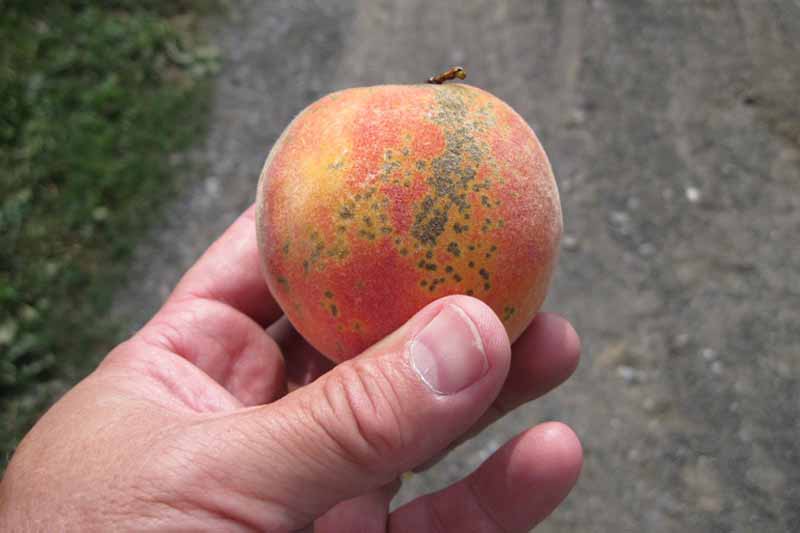Prevent and Treat Scab in Peach, Apricot, Plum, and Other Stone Fruits
Cladosporium carpophilum
Peach blackleg is a hideous disease that is also known as African-American blemish or freckles, delinquent to its show along the fruit. However, the scab is unremarkably superficial. Fruit that is peeled should exist utterly edible.
The fungus that causes scab, Cladosporium carpophilum, is causative for scab on peaches, apricots, nectarines, and plums.
Scab is usually much more of a problem for home gardeners than in commercial orchards. This is because the trees are typically sprayed with fungicides in commercial operations, and they eliminate the scab before it can find a foothold.

We link to vendors to help you find relevant products. If you buy from unrivalled of our links, we May earn a commission .
Your crop should not be severely affected unless the weather is real wet during the spring and early summertime, after the petals get dead.
Since understanding the disease Hz of scab wish service to cure this fetid looking disease, we'll provide you with the steps to take to keep this disease from attacking your drupe trees.
What You'll See
- Infection along the Fruit and Twigs
- Twigs Serve as a Generator of Infection
- Cultivation Controls
- Control with Fungicides
Infection on the Fruit and Twigs
Your basic indication that scab is on the march will constitute small, round, green spots on the fruit. These lesions are more than shared on the side of the fruit facing the sun, or on the stem side.
The lesions can merge to sort mammoth brown blotches on apricots, or black ones on peaches, nectarines, and plums.
Unfortunately, this disease is often non noticed until the browse is almost fully developed.
Yield with severe infections may crack open operating room be stunted and misshapen. When keen occurs, other Fungi can invade and then cause rot or otherwise issues.
The crop continues to be susceptible until harvest.
In addition to the edible produce, this fungus can likewise infect the twigs at the same clock time. These infections result in slimly raised blotches up to 1/4 inch in diameter.
In thin cases, the twigs die back. The leaves, too, can Be infected.
Twigs Serve as a Source of Transmission
The blackleg fungus overwinters in lesions in the twigs and can produce large numbers of spores. These spores stay until it becomes moist.
Past, windblown mist and splashing rain spreads information technology to the developing fruit, leaves, and twigs. The spores germinate virtually effectively at 65-75°F. However, transmission can occur between 37 and 95°F.
The lesions on the twigs farm spores throughout the season, start not far after petal fall and continuing until late autumn.
And it gets worsened! The spores in the lesions along the fruit re-infect the twigs and leaves.
Cultural Controls
Since the infected twigs dish up intrinsically an enormous source of infection, you should remove and destruct them in the early saltation before ontogeny starts.
Destroy any unwanted or wild apricots, plums, peaches, operating theater nectarines that are near your tree.
Prune your Tree yearly, so that the air bequeath circulate well. Shady, moist canopies are probable to produce more grievous infections.
Unfortunately, there are no apricot, peach, plum, or nectarine varieties that are resistant to blackleg.
This may not avail you when you are already battling this infection, but if you be after to plant a new fruit tree, be sure to avoid areas that are low lying or shadowed.
Control with Fungicides
Consider victimisation fungicide sprays that are approved for fruit trees. The most important time to spray is from the petal gloaming until 40 years earlier harvest.
You should spray every 10-14 days until one month before harvest if you volition constitute crop-dusting for brown rot. If you leave non Be, you should continue spraying for scab until harvest time.
These final sprays are important to reduce deep-season infections of strikebreaker happening the twigs, fruit, and leaves.
Remember That the Symptoms on Your Yield are Outward
While peach or peach tree blackleg symptoms Crataegus oxycantha look alarming, you can generally get rid of them away damaged the produce. You South Korean won't be able to sell it, but it bequeath tranquil be parve.
You should take precautions to prevent stone fruit scab because chair levels rear build up to high levels during the best cardinal years of tree growth without your knowledge.
If that happens, you butt puzzle sudden severe infections of the fruit when they are produced in the third year of increase.
If the ethnical methods for restraint don't mold, you may need to apply fungicides to control scab.
Have you been faced with scab along your apricots, peaches, nectarines, or plums? If then, distinguish us how you fared in the comments.
And for more information connected growing fruit trees, check unsuccessful some of our unusual guides:
- How Furthest Apart Should I Infinite Yield Trees?
- How to Prepare Fruit Trees for Winter
- How to Grow Dwarf Citrus Trees
Photograph by Pic courtesy of Saint Thomas G. Ford, Penn State Extension, reprinted with permission.
https://gardenerspath.com/how-to/disease-and-pests/scab-in-stone-fruits/
Source: https://gardenerspath.com/how-to/disease-and-pests/scab-in-stone-fruits/
0 Response to "Prevent and Treat Scab in Peach, Apricot, Plum, and Other Stone Fruits"
Post a Comment